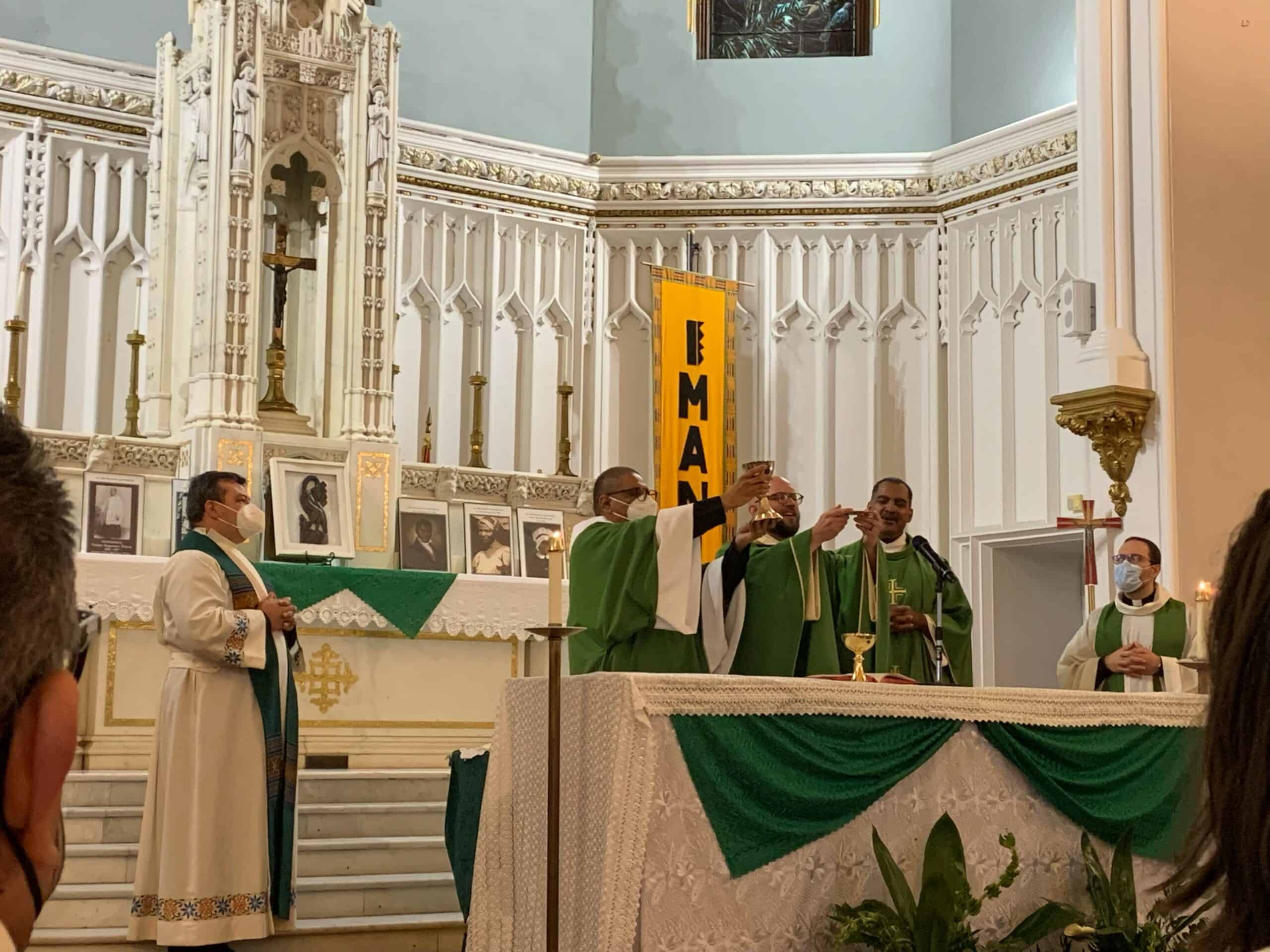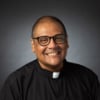As a kid, I never really understood what was going on in the mass. Fr. So-and-So (his name I cannot remember) would begin the Wednesday student mass at Visitation Catholic Church in Kansas City, Missouri, with a hearty roar, “What day of the week is it?!” All of us first through third graders would scream, “Wednesday!!” And, of course, if Fr. So-and-So couldn’t hear us he’d ask us again, with an even louder shout, “WHAT DAY OF THE WEEK IS IT?!?!” And we’d bellow, “WEDNESDAY!!!” And that was Mass for me. For the most part. I was in first grade. We’d stand at the standing parts and kneel at the kneeling parts, and some of us would giggle when Fr. So-and-So would sing the doxology, and if we had our First Holy Communion, we’d prepare God’s throne with our hands to receive the Body of Christ in our hands. For the most part, though, mass was a series of exclamations and movements.
Now, it’s safe to say that I matured. And the mass became more than what it was for me when I was a child. And yet, I still couldn’t say I completely understood what was going on. I just knew I believed what was happening before my eyes was real and true and I loved it. And then you add a deacon to the mix, and all I saw was an altar space full of men in robes doing the most important thing I’d ever see on a Sunday, or during the entire week for that matter. It wouldn’t be until I started studying theology as a full grown human person that I finally began to grasp what was occurring throughout the mass. And it wouldn’t be until I was preparing to become a deacon myself that I started to comprehend the purpose of a deacon. 1
The truth? When I entered the Society of Jesus at 34, I didn’t have an understanding or the language or the knowledge of what I called “mass-stuff.” For example, the altar paraphernalia I called the “holy plate” (paten), “the holy cup” (chalice), “the holy bowl” (lavabo). I had to look up these items and download a PDF to learn and memorize, and I did this well into my first year of theology studies three years ago.
The Jesuit Post has written some great articles about our faith, in the Catholic 101 series. What is offered in this series can help deepen one’s insight into the rituals and prayers of the Catholic faith, it has mine! Explaining the mass and all its parts is another post for another time, and better explained by young Jesuit theologians. However, what exactly does a deacon do? I was asked this question by a TJP reader once. And, yeah, they’re not wrong, I should offer some explanation. Something I should’ve done at the start of this diary. Better late than never! So here’s a quick and dirty overview of being a deacon.
Deacon…what?!
Let me start with this little tidbit, there are two “types” of deacons. One “type” is the permanent deacon. These deacons have no intention of becoming priests and might be someone you know, like your dad, or brother, or a friend. Fun fact: permanent deacons can be married, but they must be married prior to their diaconate ordination, otherwise they are to live a celibate life.
The other “type” of deacon are transitional deacons. These deacons are celibate men who have every intention of being ordained a priest. I’m a transitional deacon. Ultimately, though, all deacons, regardless of type, participate in this ministry in the same way. 2
Okay, so we have the definition, now what do deacons actually do?
Deacons, identified by the stole that is worn across the left shoulder or wearing a dalmatic (a robe with wide sleeves), are focused on service, predominantly during mass. The way a deacon assists occurs when he offers the invocations of the Penitential Rite, proclaims the Gospel, preaches the homily, reads the prayers of the faithful, receives the gifts of bread and wine, prepares the altar, aids with incensing, models posture and instructs movement, distributes Holy Communion, and dismisses the congregation.
Outside of mass, the deacon helps the priest when he baptizes; brings communion to the dying; visits the sick; visits the imprisoned; helps with sacramental preparation and religious education classes; presides at adoration and benediction; officiates wakes, funerals, and burial services; and witnesses marriages. Deacons are also able to bless people and religious artifacts.
Damian as Deacon
It’s easy to fall into compare and despair. It often feels like Catholics, and many Jesuit peers of mine, know the technical and theological history of the mass. And in these past three years here at Boston College School of Theology and Ministry, I have learned so much. And I have a terrible memory, collateral damage – I presume – from foolish, youthful choices. Yet, God called ME, which includes all that I am and all that I’m not. And I assert God knows what God is doing when God tapped me on the shoulder and invited me to consider religious life in my mid-30s. Talk to me about theatre; I know much! Until recently, talk to me about the mass, and I would stammer and stutter, and giggle in embarrassment for my lack of knowledge. I still do in some ways to this day. Like my experience going to the gym, even the most muscular person started off by picking up weights for the first time. Becoming a priest was not in my purview for most of my life As I have moved through Jesuit formation, the reality of priesthood seemed so far away in this eleven year formation process. And then suddenly it was upon me: priesthood! I’ve always been a late bloomer. So now I’m praying catch-up!
During mass I’m praying and participating as a deacon, and as a transitional deacon, I’m paying attention to how the priest is presiding mass. Perhaps it’s my theatre background, but I like to watch the different ways priests offer the mass, not by way of rubrics, but energy, personality, prayerfulness, style. I’m making mental notes: don’t do this, never do that, that move is pretty nice, and so on. For instance, there’s a priest who beautifully invites the people to stand or sit with an easy and smooth gesture of his hands.
Another priest, before the sign of the cross at the start of mass, offers a wonderful greeting to the congregation by saying: “Church family, we know that God is good and so we begin by acknowledging his presence, in the name of the Father, and of the Son, and of the Holy Spirit.” What I notice isn’t anything huge, it’s the small and simple ways, where appropriate in the rubrics of the mass, I recognize how a priest is pastoral and welcoming, how they kindle and set the mood for the congregation. And this noticing did not begin when I was a deacon. I’ve been unconsciously observing these methods since I was a child, sitting in the pews inside Visitation Catholic Church, listening to Fr. So-and-So animate elementary school children for the paschal mystery of Jesus Christ.
Here’s the thing, I may be ordained a transitional deacon, and I am learning how to preside through the modeling of other priests. But all of us are invited to pay attention, observe, and participate in the mass that is before us. I believe we instinctively know when we experience a mass that moves us, that challenges us, that comforts us, that ignites us…even a mass that leaves us wanting. I do pray that I can follow the example of Fr. So-and-So and help fertilize the faith of God’s people the way I experienced priests, deacons, sisters, brothers, parents, grandparents, friends, who have – and still do – fertilized the faith for me.
-//-
Photo courtesy of the author.
- Caveat: I might have been poorly catechized, or I might have not paid much attention in school, I wasn’t the greatest student. It took me a while to accept that – be it priest, or deacon, or seminarian, or faithful believer – we all start somewhere with our baseline knowledge. Like everything in life, we learn it all, it’s not all bestowed on us at birth. ↩
- Did you know the Liturgy of the Hours is for everyone, not just for priests and deacons? There is an amazing TJP Catholic 101 article about the Liturgy of the Hours that is worth reading, check it out here! ↩


